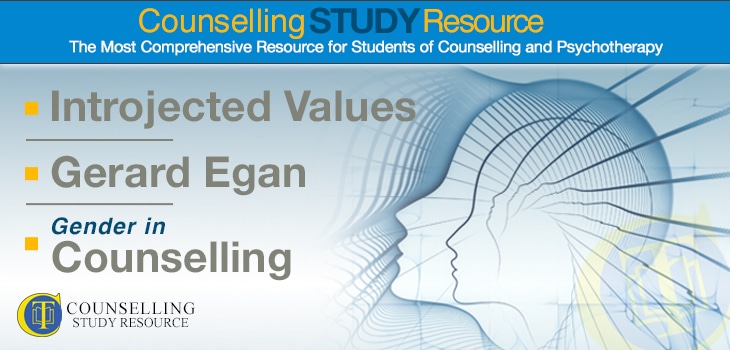025 – Introjected Values – Gerard Egan – Building a Website 2 – Gender in Counselling
In episode 25 of the Counselling Tutor Podcast, Rory Lees-Oakes and Ken Kelly discuss introjected values. ‘Theory with Rory’ looks at Gerard Egan’s model of counselling, and ‘Person-Centred Business’ suggests what pages and content you will need on your website. Finally, the presenters discuss gender in counselling.
Introjected Values
Ken and Rory discuss the difference between introjected values and conditions of worth, illustrating each with real-life examples. The concept of introjects comes from Carl Rogers’ person-centred theory; Rogers believed that introjects get in the way of people being their true (organismic) selves, causing them to adopt others’ values as their own truths. Challenging the introject of how women ‘should’ look (as implied by, say, magazine covers), Rory recommends The Beauty Myth by Naomi Wolf. A common condition of worth, meanwhile, is: ‘Big boys don’t cry.’
Gerard Egan
Currently Professor Emeritus of Psychology and Organisation Development at the Loyola University of Chicago, Gerard Egan wrote The Skilled Helper – one of the most widely read books on counselling and communication skills – in 1975.
Egan’s integrative model draws from the work of Carl Rogers and Robert Carkhuff (co-creator with Charles Truax of the Empathy Scale, available as a free download in Counselling Tutor Podcast episode 8). Egan developed a non-coercive way of helping people reach their own goals, based on three questions/stages:
- What is going on (i.e. the current scenario)? This stage subdivides into the story, blind spots and leverage.
- What do I want instead (i.e. the preferred scenario)? Here, the helper and client look at possibilities, the change agenda and commitment.
- How might I get to what I want (i.e. action strategies)? The process concludes by examining possible strategies, identifying the best fit and making a plan.
Rory identifies the counselling skills that are needed at each stage. For example, in stage 1, the counsellor needs to use silence to listen to the story; reflection and paraphrasing to identify blind spots; and focusing to create leverage. Questioning is important at stage 2, which includes supporting clients to create objectives that are SMART: specific, measurable, achievable, realistic and time-bound.
Egan believed strongly that first impressions are lasting impressions, and so that establishing a sound therapeutic relationship from the start was vital to success. Key to ensuring that the client developed this trust in the counsellor was the concept of SOLER: sitting squarely, open posture, leaning forward and looking interested, eye contact, and relaxing.
Egan’s model is quite directive, and so in some ways fits better with cognitive behavioural therapy, transactional analysis and motivational interviewing (a technique used by health professionals) than with the person-centred approach. Nonetheless, there are many connections and common features with Rogers’ work.
Rory asserts that much person-centred counselling training these days has integrative elements. Indeed, Egan’s model – though not as widely recognized as some other psychologists’ work – could be said to form the basis of much modern counselling.
Free Handout Download
Gerard Egan's SOLER
Building a Website 2
Following on from last week’s podcast on whether to design your own website or commission a professional to do so, Ken explores the pages and content you need. You will be able to use much of the material already discussed in ‘Person-Centred Business’ – for example, the elevator pitch (in which you define your offer), explained in podcast 21, is ideal to use at the start of your home page. The home page is the ‘front door’ of your website: do include a recent photo of yourself, and try to put yourself in the shoes of visitors (who may be feeling very vulnerable).
In addition to the home page, Ken recommends including:
- an ‘About’ page – describing how your skills and experience enable you to help clients
- contact details – how they can get hold of you (including different methods, and considering issues of confidentiality)
- fee information – for transparency
- other useful information – on your style, philosophy, what counselling is, where it takes place, challenging the idea that those who come to counselling are weak etc.
Gender in Counselling
Traditionally, our culture thinks of gender as binary – i.e. you are either male or female. But there is a move towards seeing gender as based on phenomenology (subjective experience) rather than taxonomy (categorisation).
As a counsellor, it is important not to make assumptions about what gender means to a client, but to see this from the client’s own frame of reference. The ‘person of tomorrow’ (to use a phrase of Carl Rogers’) may be free to choose where they fit on the gender continuum, rather than having this prescribed for them.
Links and Resources
The Beauty Myth by Naomi Wolf (published by Vintage, 1991)
